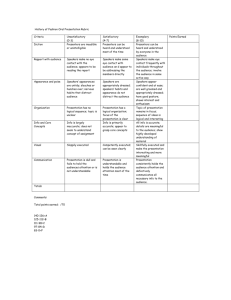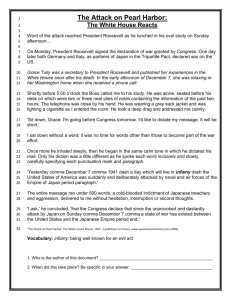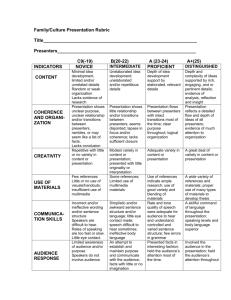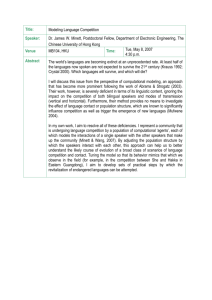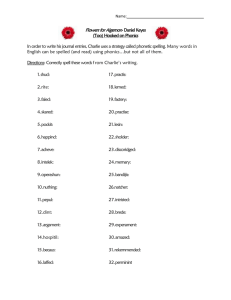Session 5 Establishing Class Culture Students as Speakers and
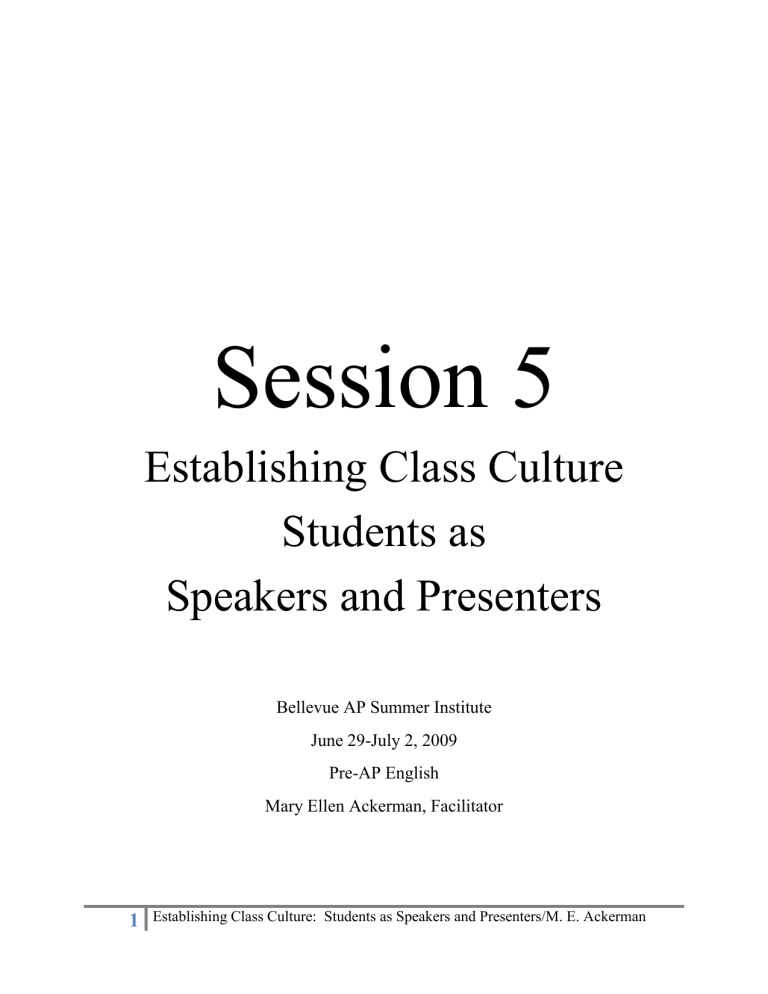
Session 5
Establishing Class Culture
Students as
Speakers and Presenters
Bellevue AP Summer Institute
June 29-July 2, 2009
Pre-AP English
Mary Ellen Ackerman, Facilitator
1 Establishing Class Culture: Students as Speakers and Presenters/M. E. Ackerman
2 Establishing Class Culture: Students as Speakers and Presenters/M. E. Ackerman
Group Discussion Model for More Effective Writing
Good discussion practices can transfer into effective writing. With a few guidelines our classrooms’ conversations can bolster our students’ thinking and writing. These guidelines are based on two premises:
1. Most people are more attached to that which they discover for themselves, rather than that which others tell them. The process of discover is self-validating.
2. Students, not teachers, are in charge of the discussion. The teacher acts only as a facilitator who initiates the discussion and steps in only when the format is being compromised.
Guidelines:
CHAIR ARRANGEMENT: The arrangement of the chairs in the room influences the effectiveness of the discussion. The best way is for all students to be able to see the face of each participant. For this reason, chairs or desks are best placed in a circle. In a circle there is no head position, so all members have equal status.
FOCUS: A teacher or student presents the significant question or prompt, and then the discussion begins. Only when the initial question has been answered to the satisfaction of the presenter and/or the group can the focus be changed.
SPEAKER CALLS ON THE NEXT SPEAKER: Whoever speaks calls on the next person and addresses that person by name. The speaker is obligated to call on the person whose hand is raised and who has spoken the least. The person called upon must make an explicit transition to show the idea relationship between the last speaker and himself.
The new speaker is obligated to make the connection obvious and continue developing the idea of the last speaker.
Other participants may raise their hands to be called upon when they want to further develop an idea, provide examples, or ask clarifying questions.
Initially speakers call only on a student whose hand is raised.
3 Establishing Class Culture: Students as Speakers and Presenters/M. E. Ackerman
KNOCKING: Whenever someone makes a statement that a student supports, students knock respectfully on their desks. Those who are not speaking still get to be heard when they knock. Knocking indicates others agree and they are expressing consensus.
Establishing and maintaining the practice of knocking is crucial. The student who is talking is getting immediate feedback and feels supported. This is an excellent confidence booster.
In time the more reticent students garner the courage to speak and eventually become more actively involved in class discussion.
If the teacher or student thinks that a student is habitually knocking to appear involved, then the teacher or student can monitor by asking that student to repeat the point of view being stated and to explain the supporting reasoning.
MONITORING: Initially teachers usually have to intervene to make sure that the guidelines are being followed.
One strategy is to distribute three different colored index cards to each student. One card is for insight, one for a question, and the third for a segue. In order for a person to speak, he must hold up the appropriate card. Once the students use up all three of their cards, they are no longer able to respond, but may continue to knock. This strategy frustrates both those students who like to monopolize discussions and those who prefer not speaking. The strategy addresses both problem areas.
Use the cards for other areas that need improvement in writing. Instead of having the categories of insight, question, and segue, you might focus on evidence or examples. The divisions in this case could be defining, clarifying, or persuasive examples.
The sense of community that this model creates fosters confidence in all students and good habits of discussion.
Students respectfully listen to each other.
This discussion model provides more equity, honoring all participants. o The more introverted students evolve into more participatory ones. o The students who monopolize discussion learn to take their turn and share discussion time.
Transitions and idea development processed in discussion transfer into effective writing skills.
4 Establishing Class Culture: Students as Speakers and Presenters/M. E. Ackerman
Continued practice and monitoring in this discussion technique makes for not only thoughtful discussions and writing, but also a strong community of learners.
In Praise of the Humble Comma
Pico Iyer
The gods, they say, give breath, and they take it away. But the same could be said, could it not, of the humble comma. Add it to the present clause, and, of a sudden, the mind is, quite literally, given pause to think; take it out if you wish or forget it and the mind is deprived of a resting place. Yet still the comma gets no respect. It seems just a slip of a thing, a pedant's tick, a blip on the edge of our consciousness, a kind of printer's smudge almost. Small, we claim, is beautiful (especially in the age of the microchip). Yet what is so often used, and so rarely recalled, as the comma, unless it be breath itself?
Punctuation, one is taught, has a point: to keep up law and order. Punctuation marks are the road signs placed along the highway of our communication, to control speeds, provide directions and prevent head-on collisions. A period has the unblinking finality of a red light; the comma is a flashing yellow light that asks us only to slow down; and the semicolon is a stop sign that tells us to ease gradually to a halt, before gradually starting up again.
By establishing the relations between words, punctuation establishes the relations between the people using words.
That may be one reason why schoolteachers exalt it and lovers defy it ("we love each other and belong to each other let's don't ever hurt each other Nicole let's don't ever hurt each other," wrote Gary Gilmore to his girlfriend). A comma, he must have known, "separates inseparables," in the clinching words of H.W. Fowler, King of English
Usage.
Punctuation, then, is a civic prop, a pillar that holds society upright. (A run-on sentence, its phrases piling up without division, is as unsightly as a sink piled high with dirty dishes.) Small wonder, then, that punctuation was one of the first proprieties of the Victorian age, the age of the corset, that the modernists threw off: the sexual revolution might be said to have begun when Joyce's Molly Bloom spilled out all her private thoughts in 36 pages of unbridled, almost unperioded and officially censored prose; and another rebellion was surely marked when E. E. Cummings first felt free to commit "God" to the lower case.
Punctuation thus becomes the signature of cultures. The hot-blooded Spaniard seems to be revealed in the passion and urgency of his doubled exclamation points and question marks ("a Caramba! Quien sabe"), while the impassive
Chinese traditionally added to his so-called inscrutability by omitting directions from his ideograms. The anarchy and commotion of the '60s were given voice in the exploding exclamation marks, riotous capital letters and Day-Glo italics of Tom Wolfe's spray-paint prose; and in Communist societies, where the State is absolute, the dignity, and divinity of capital letters is reserved for Ministries, SubCommittees and Secretariats.
Yet punctuation is something more than a culture's birthmark: it scores the music in our minds, gets our thoughts moving to the rhythm of our hearts. Punctuation is the notation in the sheet music of our words, telling us when to rest, or when to raise our voices; it acknowledges that the meaning of our discourse, as of any symphonic composition, lies not in the units but in the pauses, the pacing and the phrasing. Punctuation is the way one bats one's eyes, lowers one's voice or blushes demurely Punctuation adjusts the tone and color and volume till the feeling comes into perfect focus: not disgust exactly, but distaste; not lust, or like, but love.
5 Establishing Class Culture: Students as Speakers and Presenters/M. E. Ackerman
Punctuation, in short, gives us the human voice, and all the meanings that lie between the words. "You aren't young, are you?" loses its innocence when it loses the question mark. Every child knows the menace of a dropped apostrophe (the parent's "Don't do that" shifting into the more slowly enunciated "Do not do that"), and every believer, the ignominy of having his faith reduced to "faith." Add an exclamation point to "To be or not to be . . ." and the gloomy Dane has all the resolve he needs; add a comma, and the noble sobriety of "God save the Queen" becomes a cry of desperation bordering on double sacrilege.
Sometimes, of course, our markings may be simply a matter of aesthetics. Popping in a comma can be like slipping on the necklace that gives an outfit quiet elegance, or like catching the sound of running water that complements, as it completes, the silence of a Japanese landscape. When V.S. Naipaul, in his latest novel, writes, "He was a middleaged man, with glasses," the first comma can seem a little precious. Yet it gives the description a spin, as well as a subtlety, that it otherwise lacks, and it shows that the glasses are not part of the middle agedness, but something else.
Thus all these tiny scratches give us breadth and heft and depth. A world that has only periods is a world without inflections. It is a world without shade. It has a music without sharps and flats. It is a martial music. It has a jackboot rhythm. Words cannot bend and curve. A comma, by comparison, catches the gentle drift of the mind in thought, turning in on itself and back on itself, reversing, redoubling and returning along the course of its own sweet river music; while the semicolon brings clauses and thoughts together with all the silent discretion of a hostess arranging guests around her dinner table.
Punctuation, then, is a matter of care. Care for words, yes, but also, and more important, for what the words imply.
Only a lover notices the small things: the way the afternoon light catches the nape of a neck, or how a strand of hair slips out from behind an ear, or the way a finger curls around a cup. And no one scans a letter so closely as a lover, searching for its small print, straining to hear its nuances, its gasps, its sighs and hesitations, poring over the secret messages that lie in every cadence. The difference between "Jane (whom I adore)" and "Jane, whom I adore," and the difference between them both and "Jane, whom I adore," marks all the distance between ecstasy and heartache.
"No iron can pierce the heart with such force as a period put at just the right place," in Isaac Babel's lovely words: a comma can let us hear a voice break, or a heart.
Punctuation, in fact, is a labor of love. Which brings us back, in a way, to gods.
From Iyer, Pico. 13 June, 1988. In praise of the humble comma. Time, 80. Copyright C) 1988 Time Inc. All rights reserved. Reprinted BV Permission from Time.
6 Establishing Class Culture: Students as Speakers and Presenters/M. E. Ackerman
Audience, Purpose, Situation Activity
Task: to teach the significance of audience, purpose, and situation as crucial components in writing and speaking for successful communication.
Components:
Red rectangle
Green square
Purple triangle
Yellow rectangle
General Directions: Step One
All students have the same set of pieces of construction paper both in size and shape. Have students pair up with their backs to one another such that they cannot see each other’s pieces of construction paper.
Have one student in each pair arrange the pieces on the desk and give instructions to the student whose back is next to him or her. The student can only repeat each direction once. The listener who is trying to make the same configuration cannot give any feedback or ask any questions.
After the directions are completed, the pairs should look at each other’s arrangement to see where miscommunication may have occurred and figure out why. They are to decide how to rectify the situation.
Next the partners switch roles, taking into account what they learned. The listener now becomes the speaker and gives the directions, repeating only once. The speaker-turned-listener cannot give any feedback or ask questions.
After the directions are completed, the pairs should look at each other’s arrangement to see where miscommunication still may have occurred and figure out why. They are to decide how to rectify the situation.
What conclusions about this activity do the participants have?
General Directions: Alternative Step One
If the only teacher gives directions, give these directions:
1.
Take the red piece and put it long side down, parallel to the bottom of the table/desk.
7 Establishing Class Culture: Students as Speakers and Presenters/M. E. Ackerman
2.
Put the green piece on the center of the red piece.
3.
Take the purple piece and put it on top of the red piece.
4.
Put the yellow piece on the center top of the purple piece.
Specific Directions for Math savvy audience: Step Two
1.
Take the red rectangle and place it such that the longer sides are horizontal to the edge of the desk/table.
2.
Place the purple triangle above the red rectangle so that the hypotenuse coincides with the longer side of the red rectangle.
3.
Place the yellow rectangle on the table so that the longer sides are horizontal and the midpoint of one of the longer sides touches the vertex of the triangle.
4.
Place the green square in the center of gravity of the red rectangle.
What conclusions about this activity do the participants have?
8 Establishing Class Culture: Students as Speakers and Presenters/M. E. Ackerman
Poem Title________________
Poet_____________________
Focus: Sound devices (rhythm and rhyme)
Device: Effect:
Poem Title________________
Poet_____________________
Focus: Allusions
Reference: Transference/Effect
Poem Title_________________ Poem Title_____________________
Poet__________________________ Poet_______________________
Focus: Figurative language
Device: Effect
Focus: Structure
Device: Effect
9 Establishing Class Culture: Students as Speakers and Presenters/M. E. Ackerman
Multiple Choice Test-taking Strategy
Adapted from Tim Averill, AP Consultant
Premises:
The smaller the discussion group, the more participants are involved.
Students are less threatened and more apt to contribute when discussing in smaller groups.
Students explore more deeply the thinking rationale involved in the selection of the answers.
The students are engaged in metacognition, the self-regulating of their understanding.
The students are doing the “teaching,” and the teacher is facilitating
Process:
Give multiple-choice test and have students record answer on answer sheet.
Break into small groups according to purpose.
Choose randomly or differentiate members so that each group has a variation of skill, ability, or personality type according to desired outcome.
Students in each group have to come to a consensus on each answer.
Students persuade each other by demonstrating the reasoning in the selection.
Students must be able to defend and offer evidence for choice.
One student from each group has to report out to the other groups in a whole group setting.
All groups must have the same answer.
If groups have differing answers, they must say “hold” and continue to the next question.
After all the questions are asked, the group goes back to the “holds” and negotiates which is the correct answer for the contested items.
All groups must reach consensus on the answers.
All students have agreed on one answer for each item.
Teacher goes through the answer key with the students.
Teacher corrects any wrong answer and explains reasoning.
All students receive the same grade.
10 Establishing Class Culture: Students as Speakers and Presenters/M. E. Ackerman
Metacognitve
Today’s session will impact my curriculum, instruction, and assessment in the following ways:
As a result, I have set the following goals which will help put into effect the ideas as stated above:
11 Establishing Class Culture: Students as Speakers and Presenters/M. E. Ackerman
12 Establishing Class Culture: Students as Speakers and Presenters/M. E. Ackerman
